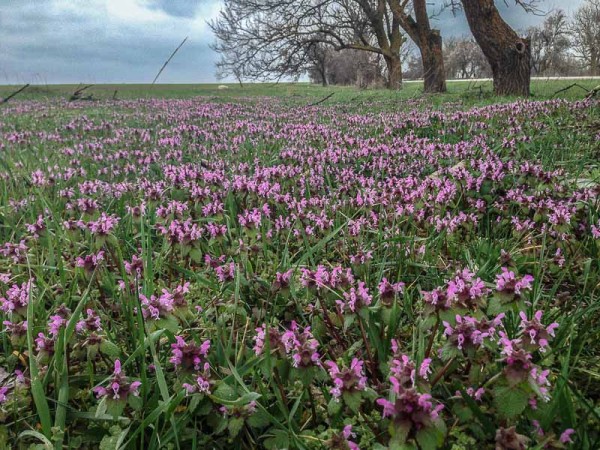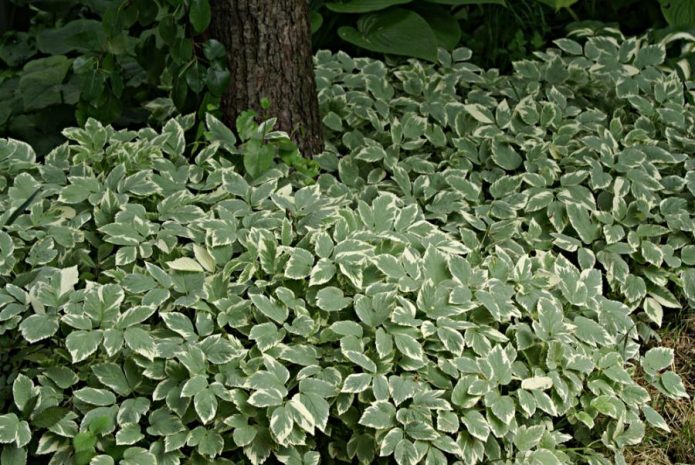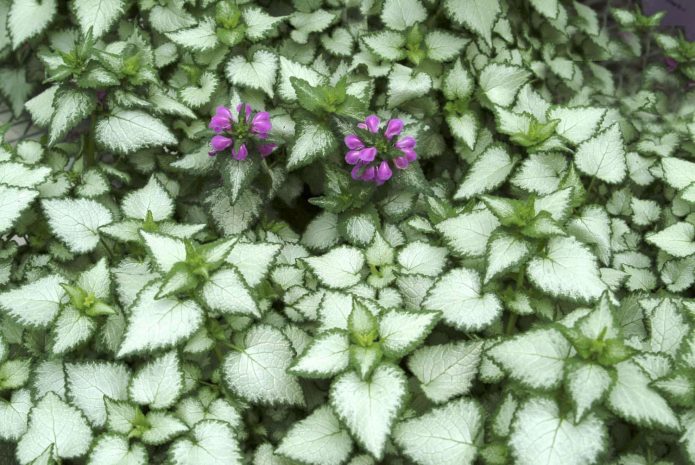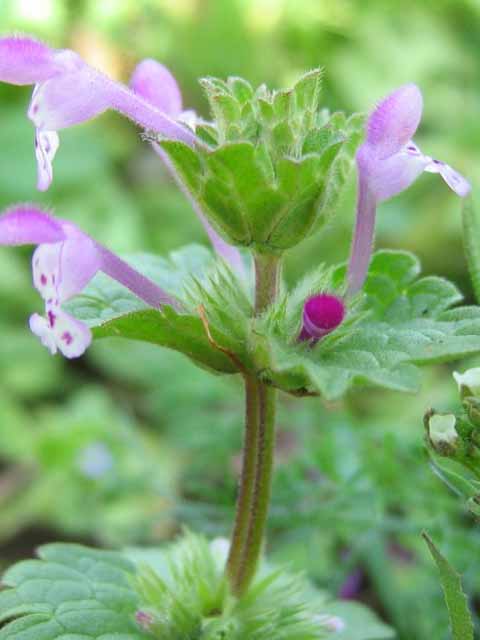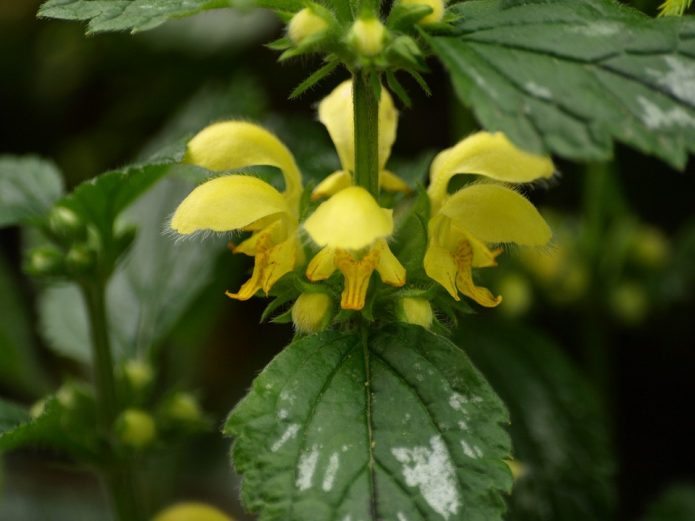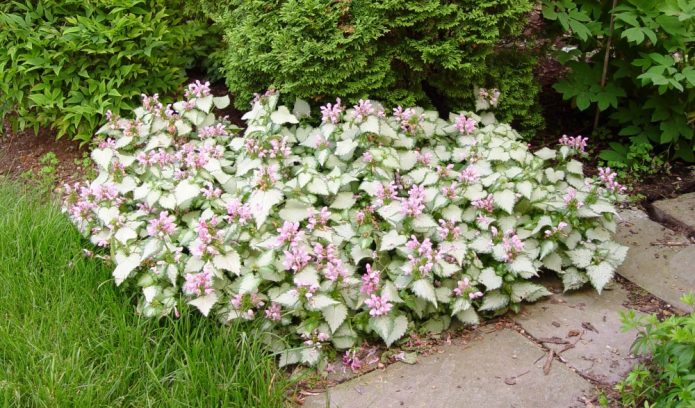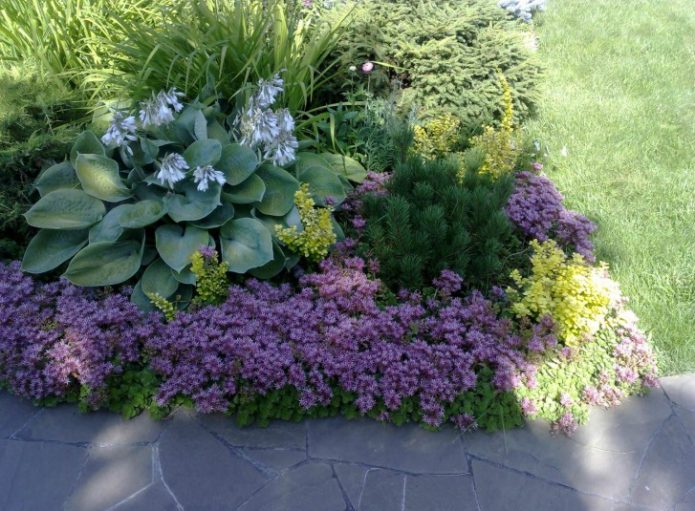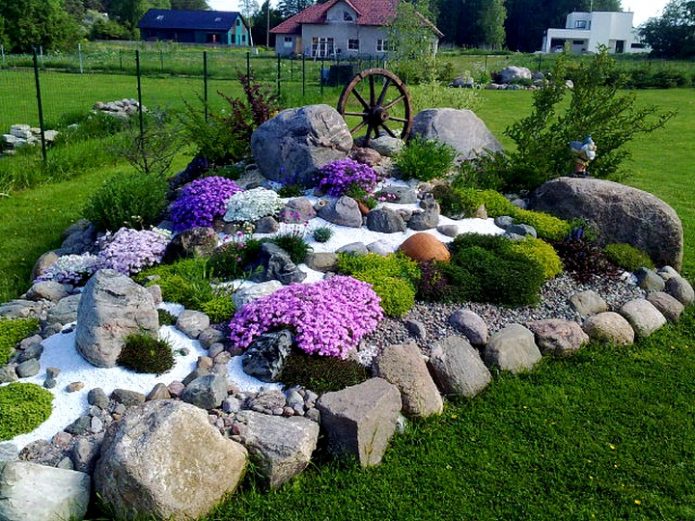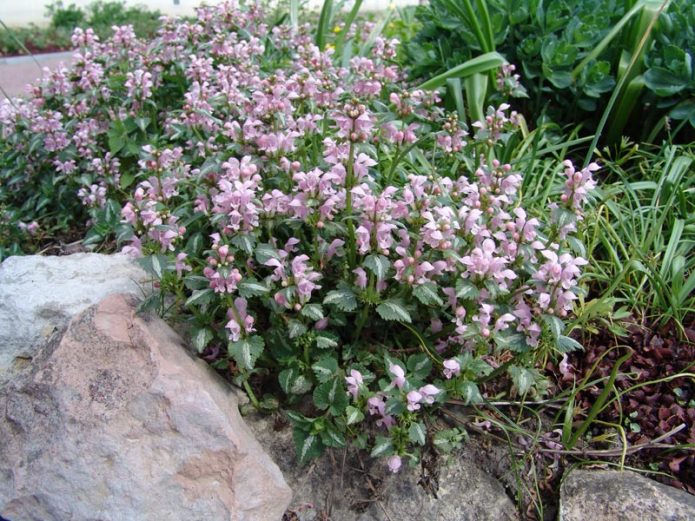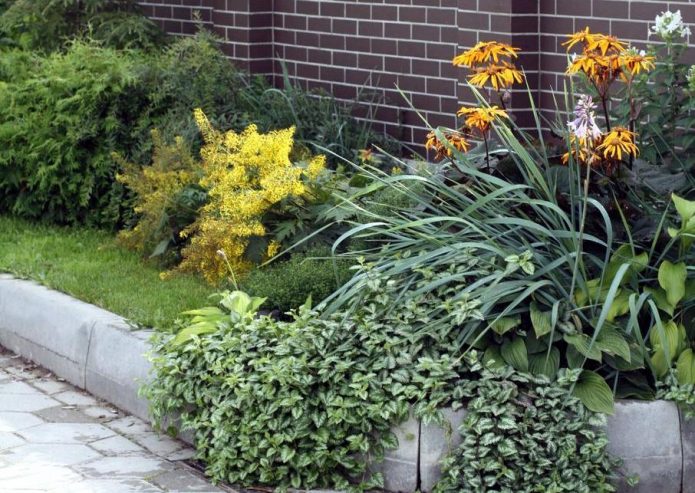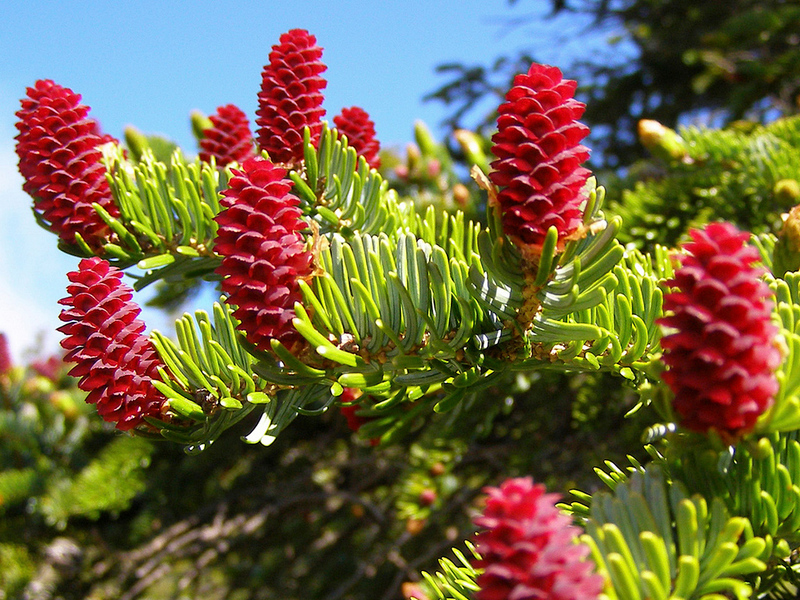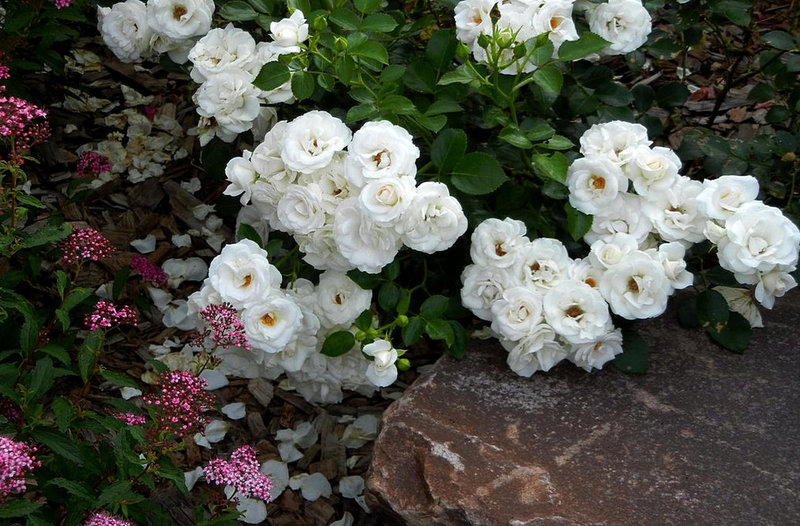The high survival rate, unpretentiousness of the plant, which is often considered a weed, attracted the attention of landscape designers. Where it is necessary to quickly plant greenery on the site, the lamb is indispensable: it has beautiful leaves with a silvery tint. Small but cute snapdragon-like flowers can be yellow, white, purple, pink.
Content
What is a plant in nature
The plant belongs to the family of the lamellar, or labiate. Natural places of growth - in Europe, Asia, in the north of Africa. According to the "life span", it can be both an annual and a perennial. According to the "way of life" - wild grass and cultivated plant. Its favorite places in the wild are roadsides, forests (deciduous and coniferous), river banks.
The stem of the lamb is recumbent, branching, and the area on which the flowers are located is erect. The leaves are almost the same in shape as those of nettles, but without scalding hairs. In addition, their color is much more varied, especially in cultivated varieties. Nevertheless, a second name was assigned to the plant, emphasizing the external similarity of plants - "deaf nettle".
Varieties and types with photos
One of the wild representatives of the family should be highlighted. This is a glabrous (field), which got its name from its long bare stem. In many territories of Russia, for example, in the Crimea, it is included in the Red List of Protected Flora. Its populations are monitored in nature reserves and grown in Moscow and the Nikitsky Botanical Garden.
In nature, there are dozens of plant species. In gardens, parks, summer cottages, only a few species and varieties are used.
White
One of the most common types. He prefers humid places (for example, the banks of ravines), in the garden he can choose abandoned corners. An excellent honey plant that attracts bees with delicate white flowers.
Magenta (speckled)
Because of the purple and pink inflorescences, this species is often called "red nettle". The plant covers the ground with a beautiful carpet. The height of the stems with flowers does not exceed 25 cm. Strong cold can destroy the purpurea, although it is considered frost-resistant.
Zelenchukovaya
According to different classifications, this species also includes yellow (Lamium galeobdolon). The height of the flowering shoot reaches 30 cm. The plant has especially good leaves - dark green with silvery spots, located closer to the jagged edge and base of the leaf blade. The flowers are yellow, rather large. The short flowering period (in May) is compensated by the fact that in summer it can form buds again.
Variegated
This species is often referred to as zelenchuk and is called “yellow variegated”. In Europe, another name is common - "yellow archangel". One of the popular names for the species is "earthy incense". The height of the shoot above the ground reaches 60 cm.
Variegated also includes Friday. Its height is up to 85 cm. In the center of the leaf there is a yellow-green spot.
Spotted
Specialists sometimes refer to the spotted lamb as "speckled", but more often they distinguish it as a separate species. The decorativeness of the plant is provided by purple buds and oval-shaped leaves with a silver or white stripe in the middle. This species blooms all summer long, under favorable conditions - until October.
Embracing
The height of the stem with purple flowers is from 15 to 30 cm. The species got its name due to the upper leaves "hugging" the stem. The flowers have a delicious honey smell that attracts bees, but people with this type of lamb should be careful - in a number of European countries, the plant is officially recognized as dangerous to human health.
Yellow (golden anniversary)
In this species, not only flowers have a yellow color, but also a pattern on the leaves covered with soft nap. The height of the stem is 30 cm. With the help of good care, it is possible to achieve that the stems of the yellow lamb rose above the ground by 60 cm. The buds are large, in each inflorescence there are 6 of them.
Breeders are successfully developing new varieties. The most successful and popular with flower growers are such varieties:
- Argenteum and Beacon Silver - with large purple buds.
- Checkers - with purple leaves.
- Album and White Nancy - with snow-white flowers.
- Aureum - with yellow leaves.
- Silbergroschen - purple flowers.
- Pink Nancy and Anne Greenaway - with pink buds.
Medicinal properties and contraindications
All species of this plant have healing properties. To a greater extent, they are possessed by white lamb. In folk medicine, the plant is famous for hemostatic, expectorant, diuretic and other properties. It is used to treat gastric, pulmonary and gynecological diseases. The plant also helps to cope with toothache, depression, and is effective in wound healing. Ways of application - decoctions, teas, compresses, baths and lotions.
Application in medicine of other types:
- Purple is used to treat skin diseases - urticaria, eczema, diathesis, furunculosis.
- The speckled look is effective in the treatment of liver and kidney, gynecological diseases. Traditional medicine considers this plant to be one of the main ones in the treatment of insomnia and nervous disorders.
- Stema is used to treat bronchitis and asthma, jaundice and malaria.
Most plant species are not poisonous, but this natural medicinal product cannot be abused. At risk are hypotensive patients and people suffering from atonic constipation.
The use of clearness in landscape design
The main purpose of this ornamental plant, from the point of view of landscape designers, is a ground cover. In this regard, it does not have many worthy competitors. Main ways to use:
- registration of borders;
- closing the soil around the bushes;
- landscaping shaded, abandoned, unsightly areas of the garden;
- decoration of alpine slides;
- decoration of flowerpots (in them the plant acts as an ampelous culture).
Experts attribute to the advantages of the lamb that its greenery is one of the earliest in the garden (under the snow the plant leaves with green leaves and tolerates cold well).
An important point for designers is the variety of shades not only of flowers, but also of leaves, which even more take “responsibility” for the decorativeness of the plantings.
Keeping in mind that the lamb is not averse to acting as an "occupier", experts advise to grow it where there are any obstacles that limit the uncontrolled spread of the plant. This can be the distance between the wall of the house and the asphalt area; Paving “windows”; territories bounded on all sides by stone slabs of paths. By the way, on the allotted "patch" the plant sets its own rules, completely suppressing the growth of such malicious weeds as thistle and dandelion.
Due to the fact that the root system of the plant is located in the surface layers of the soil, it is planted near shrubs and trees. The plant looks especially organic near coniferous crops - junipers, spruces, thuja and firs.
With the help of a clear note, you can create original design compositions. Example - "Stone island among the silvery-green waves." The higher the improvised rock is, the more interesting it will look. It is better to use a minimum stone height of 80 cm. It is also important that the “rock” and “sea” of living plants contrast in color.
Another option is to cultivate a tall pot (a plastic bucket and a high tire will do). If you install such a container on a lawn (or even on asphalt), the plant will very quickly close its walls, as if flowing down them with silvery-green streams of its leaves. This composition looks picturesque and mysterious.
It coexists well with those actively used in landscape design:
- tulips;
- hyacinths;
- hosts;
- narcissists;
- mikhenia nettle leaf;
- lungwort;
- heychera;
- ferns.
Landing in open ground
In order for the beetle to feel good at a summer cottage or in a park, one must try to create conditions for it that the plant is accustomed to in its natural environment. They are rather modest: a shaded place where there is no sun, slightly damp soil, and not the most fertile, for example, loam or sandstone. The cultivated layer (low or moderate acidity) should not be large - 8-10 cm is quite enough.
If the terrain on the site is hilly, this is an ideal option: the plant loves ravines, tree-covered slopes, the banks of reservoirs. It is especially conveniently located on the northern slopes, but the southern and southwestern ones are undesirable for it.
The plant will successfully develop under the crown of trees (as often happens in nature), but will suffer from the proximity to powerful herbaceous crops, especially if they are cereals.
Attention: too strong a shadow is still contraindicated for a lucid - its leaves become smaller and lose their decorative effect, their "silver" fades.
After the place is chosen, they begin to plant. There are three breeding options:
- Dividing a bush is a very simple way to ensure quick results. The plant quickly takes root and, if planted in spring (the best dates are from April to May), it starts blooming in the same summer.
- Cuttings are allowed during the entire growing season. Cut off shoots without any preliminary treatment are immediately planted in the soil, fixing well. The best cuttings are the top of the plant with buds and leaves and a bare stem, 5 cm long.
- Sowing with seeds ensures the emergence of seedlings in a month and a half. The soil must be moist so that the seeds can be slightly pressed into it. Seedling is possible, but not rational.
Care features
Despite the fact that this plant is unpretentious, it is impossible to act according to the principle of "planted and forget": the ornamental culture will behave like a weed, and, accordingly, look like that.
The lamb needs additional feeding, especially in the initial period of its growth.Mullein is applied in liquid form, and mineral fertilizers (preferably nitrogenous) in dry form, sprinkling them directly on the leaves. Two dressings per season (early summer and August) are enough. At the same time, it is important not to overfeed the plant - it can become "aggressive" and all its green neighbors will begin to survive.
The plant tolerates water interruptions well; it reacts much worse to too high soil moisture. However, if the drought is prolonged, the decorativeness of the plantings deteriorates markedly. Therefore, moderate and regular watering is what will make the claw attractive.
Obligatory procedures - pruning faded plants and removing excess shoots. In this way, planting can be rejuvenated, give plants a compact form. In addition, the likelihood of self-seeding is excluded, which would lead to excessive planting density. Another pruning is carried out at the end of autumn, preparing the plants for winter. The stems should be 10-15 cm long.
The lamb does not practically suffer from pests and diseases. In summer, it can sometimes be attacked by whiteflies and spider mites, but usually copes with the problem on its own, without requiring the use of any chemicals. If the soil is waterlogged, mold may appear. In this situation, the affected parts of the plants are removed, the intensity of watering is reduced. If the problem repeats after some time, the plantings are treated with a fungicide.
Lamb is most often cultivated as a perennial ground cover crop, however, good plant care will reward the gardener and summer resident with an evergreen carpet of beautiful leaves and flowers of various colors. If necessary, plantings can be easily restored using cuttings or seeds, without first growing seedlings.
